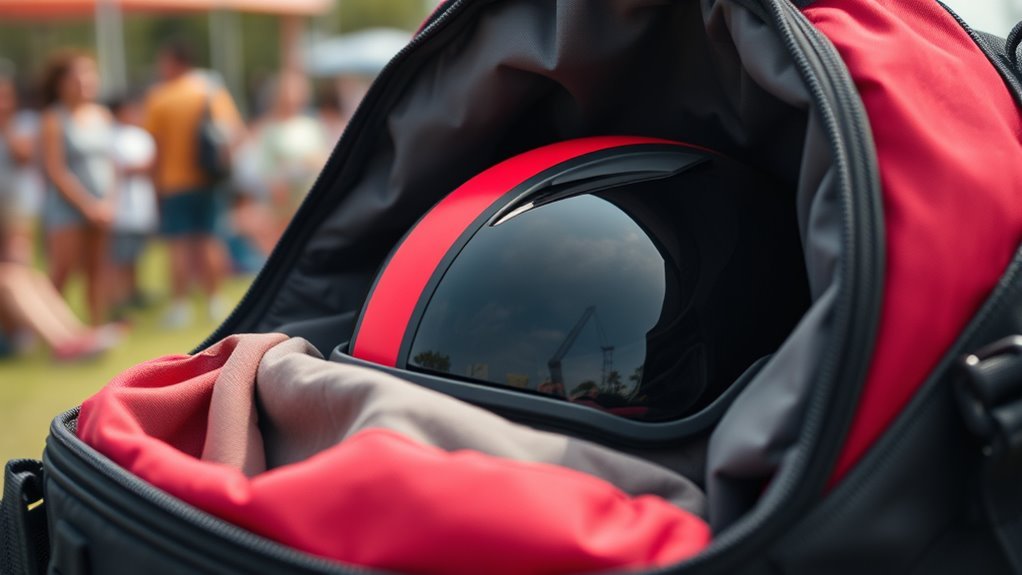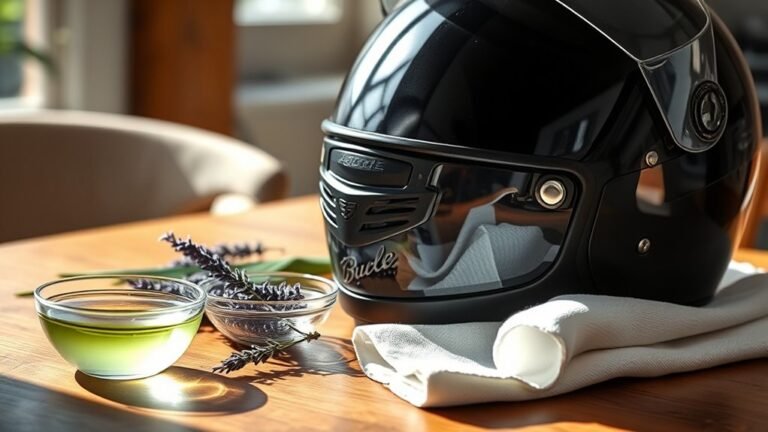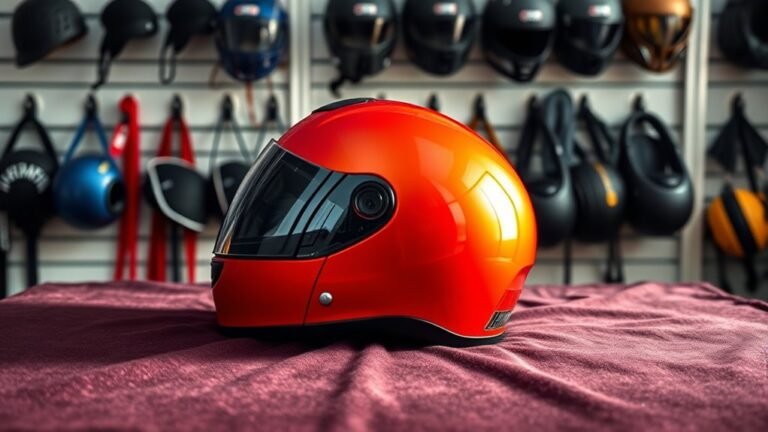How to Safely Transport Your Helmet to Events
To safely transport your helmet to events, start by choosing a durable bag or case with padding to protect it from bumps. Secure your helmet with adjustable straps and helmet clips to prevent movement. Use weatherproof storage solutions to shield it from rain and sunlight. Avoid placing heavy items on top, which can deform it. Finally, inspect for any damage before transport. There’s more to keep your helmet in top shape during your travels.
Choosing the Right Bag or Case
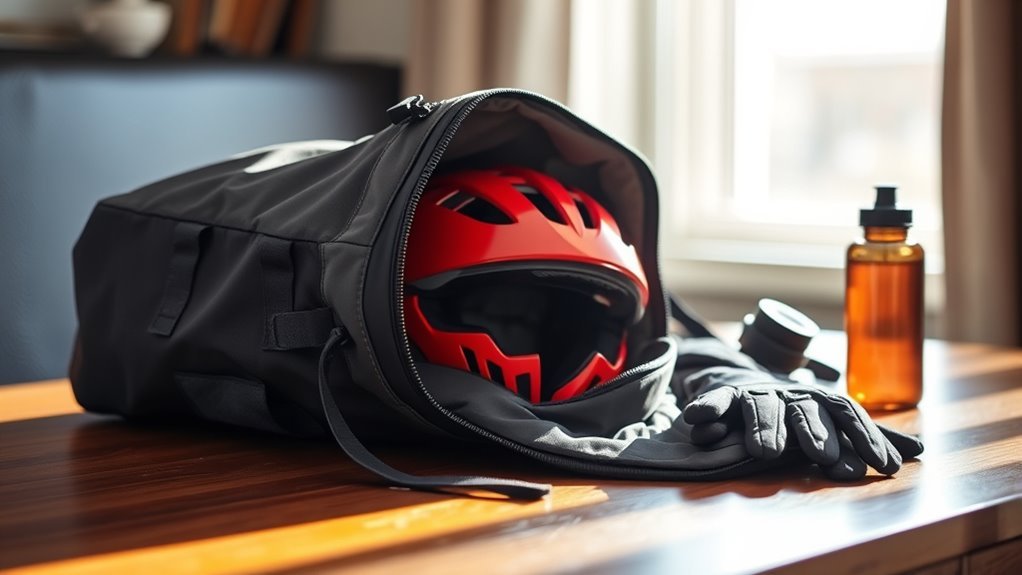
When it comes to transporting your helmet, the right bag or case can make all the difference. Start by considering bag materials; durable fabrics like nylon or polyester offer excellent protection against wear and tear. Look for options with padding to shield your helmet from bumps during travel. You’ll also want to explore carrying options—shoulder straps provide hands-free convenience, while handles allow for easy grabbing. Some cases even come with backpack straps, giving you versatility on the go. Ascertain the bag fits your helmet snugly to prevent movement, which could lead to damage. By choosing the right combination of materials and carrying methods, you’ll keep your helmet safe while maintaining the freedom to explore.
Properly Securing Your Helmet
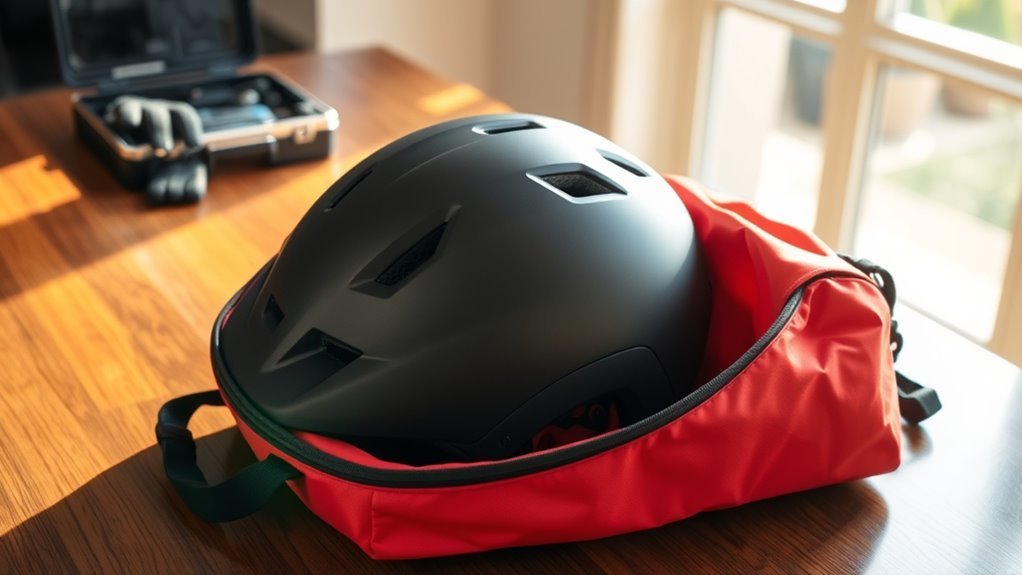
To guarantee your helmet remains secure during transport, it’s important to utilize the proper fastening techniques. Start by adjusting the helmet straps to make certain they fit snugly but comfortably. Loose straps can lead to your helmet shifting or even falling out during movement. Next, use helmet clips to fasten the helmet securely to your bag or case. Ascertain the clips are tightly engaged, preventing any accidental disengagement. If your helmet features additional retention systems, like chin straps, secure those as well. Remember, a well-secured helmet not only protects your gear but also maintains its shape and integrity. By taking these steps, you’ll transport your helmet with confidence, allowing you to focus on enjoying your next adventure.
Protecting Against Environmental Elements
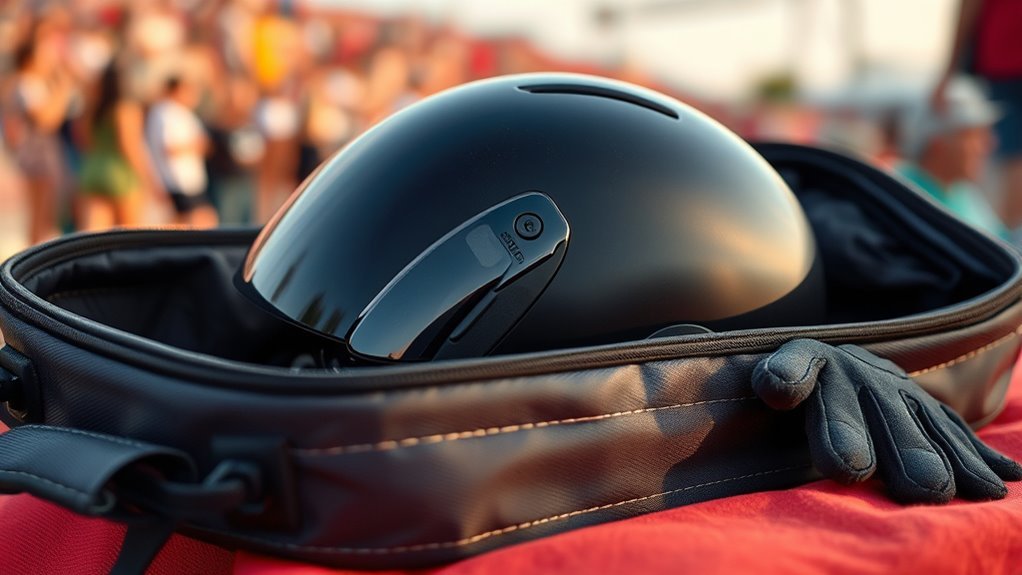
When transporting your helmet, it’s essential to shield it from environmental elements that can cause damage. Consider using weatherproof storage solutions to protect against rain and sun exposure, while incorporating UV protection techniques to prevent fading and deterioration. Don’t overlook moisture control methods, as keeping your helmet dry will guarantee its longevity and performance.
Weatherproof Storage Solutions
Although you might think a helmet is sturdy enough to withstand the elements, proper weatherproof storage solutions are essential for maintaining its integrity. Consider investing in portable storage options made from weather resistant materials. Hard-shell cases offer excellent protection against rain and impact, ensuring your helmet stays in top shape. If you prefer something lighter, padded bags with water-resistant coatings can be a great alternative. Always choose a storage solution with secure straps or zippers to prevent accidental openings during transport. Additionally, keep your helmet away from direct exposure to moisture and extreme temperatures, as these can degrade the materials over time. By employing these weatherproof storage strategies, you can enjoy your rides without worrying about environmental damage.
UV Protection Techniques
Protecting your helmet from harmful UV rays is essential for its longevity and performance. To shield your helmet effectively, consider using UV protective materials when selecting a storage bag or case. These materials can greatly reduce direct exposure to sunlight, preserving the integrity of your helmet’s outer shell.
Additionally, helmet sunshades are a fantastic option for outdoor events. They not only provide shade but also help minimize UV damage during transport. When you know you’ll be in the sun, simply attach a sunshade to your helmet.
Always store your helmet in a cool, shaded place when not in use. By implementing these techniques, you’ll guarantee your helmet remains in prime condition, ready for your next adventure.
Moisture Control Methods
While shielding your helmet from UV rays is important, managing moisture is just as vital for maintaining its performance and longevity. To guarantee effective humidity control, consider using moisture-absorbing bags, which can be placed inside the helmet when transporting it. These bags help absorb excess moisture, preventing mold and odors. Additionally, employing ventilation techniques during transport is essential. Use a breathable helmet bag that allows air circulation, reducing the risk of trapped moisture. If you’re traveling in a humid environment, try to open the bag periodically to promote airflow. By implementing these methods, you’ll keep your helmet in peak condition, ready for your next adventure without the worry of environmental damage.
Avoiding Heavy Pressure on the Helmet
When transporting your helmet, it’s essential to choose a storage method that minimizes pressure on it. Consider using soft padding materials, like foam or cloth, to cushion the helmet and prevent deformation. By taking these steps, you’ll help maintain the integrity and safety of your helmet during transit.
Choose Proper Storage Method
To guarantee your helmet stays in ideal condition, choosing the right storage method is essential. Different helmet types may require specific care, so consider the materials used in both the helmet and storage options. For instance, a hard shell helmet can tolerate some pressure but still needs adequate support. Avoid placing heavy objects on top of your helmet, as this can deform its shape and compromise safety. Instead, use soft storage materials like padded bags or dedicated helmet cases that prevent unnecessary pressure. When storing, keep it in a cool, dry place, away from direct sunlight, as extreme temperatures can weaken the materials. By selecting appropriate storage methods, you can ascertain your helmet remains safe and ready for your next adventure.
Use Soft Padding Material
Using soft padding material is essential for preventing heavy pressure on your helmet during transport and storage. Proper helmet cushioning guarantees that your gear remains intact and ready for use. Here are some recommended padding types to reflect upon:
| Padding Type | Benefits | Ideal Use |
|---|---|---|
| Foam Padding | Lightweight and shock-absorbing | Everyday transport |
| Neoprene Padding | Water-resistant and durable | Outdoor events |
| Cloth Padding | Soft and breathable | Long-term storage |
| Gel Padding | High comfort and support | High-impact activities |
Checking for Damage Before Transport
Before you pack your helmet for transport, it’s essential to inspect it for any signs of damage. Using visual inspection techniques, carefully examine the exterior for cracks, dents, or scratches that could compromise its integrity. Don’t forget to check the straps and buckles for frays or breaks. Employ impact assessment methods by pressing gently on the helmet to feel for any unusual shifts in structure.
Here are a few things to look for:
- Cracks or deep scratches on the surface
- Loose or damaged padding inside
- Frayed straps or malfunctioning buckles
Storing Your Helmet at the Event
While you’re at the event, it’s essential to store your helmet properly to protect it from potential damage and make certain it’s ready for use when needed. Choose a designated spot for your helmet that’s easily accessible, yet safe from crowd traffic. Avoid placing it on the ground where it could be stepped on or kicked. Instead, use a helmet bag or hang it on a hook if available. Confirm your helmet placement is stable, preventing it from rolling or falling. Keep it away from direct sunlight or extreme temperatures, which could compromise its integrity. By being mindful of these details, you’ll make sure your helmet stays in great shape and is always ready for your next adventure.
Frequently Asked Questions
Can I Carry My Helmet on a Motorcycle?
Yes, you can carry your helmet on a motorcycle, but it’s essential to guarantee proper helmet storage for safety. Consider using a helmet lock or securing it in a bag to keep it visible and protected. Avoid placing it on the seat, as it can easily fall off. Make certain it’s not obstructing your view or causing distractions while riding. Your helmet’s condition is critical for your freedom and safety on the road.
Is It Safe to Transport a Damaged Helmet?
Transporting a damaged helmet is like trying to carry a ticking time bomb; it’s incredibly risky. You shouldn’t take chances with helmet safety. If there’s any visible damage—like cracks or dents—it’s best to replace it rather than transport it. Follow transport guidelines strictly to guarantee you’re not compromising your safety. Always prioritize your well-being and wear a helmet that’s in perfect condition. Freedom on the road should never come at a cost.
How Do I Clean My Helmet Before Transport?
To clean your helmet before transport, start by removing any detachable parts, like the visor. Use a soft cloth and mild soap mixed with water to wipe the exterior. For the interior, use a damp cloth to gently clean the padding. Avoid harsh chemicals. Rinse thoroughly and let it air dry completely. Following these helmet care and cleaning tips guarantees your helmet stays in top shape, ready for your next ride.
What Should I Do if My Helmet Gets Wet?
If your helmet gets wet, don’t fret—it’s fixable! First, gently wipe off excess water with a soft cloth. For drying techniques, place it in a well-ventilated area, avoiding direct sunlight or heat sources, which can warp the materials. To guarantee proper helmet care, leave the padding out to air dry separately. Once everything’s dry, check for any damage before using it again. Your helmet deserves the best treatment, just like you!
Can I Use a Regular Backpack for My Helmet?
You can use a regular backpack for your helmet, but it’s not the best option for helmet protection. Look for a backpack type with a padded compartment or one specifically designed for helmets. This’ll help prevent damage during transport. If you’re using a standard backpack, make certain to wrap your helmet in a soft cloth to minimize impact from other items. Prioritizing your helmet’s safety guarantees you can ride freely without worry.
